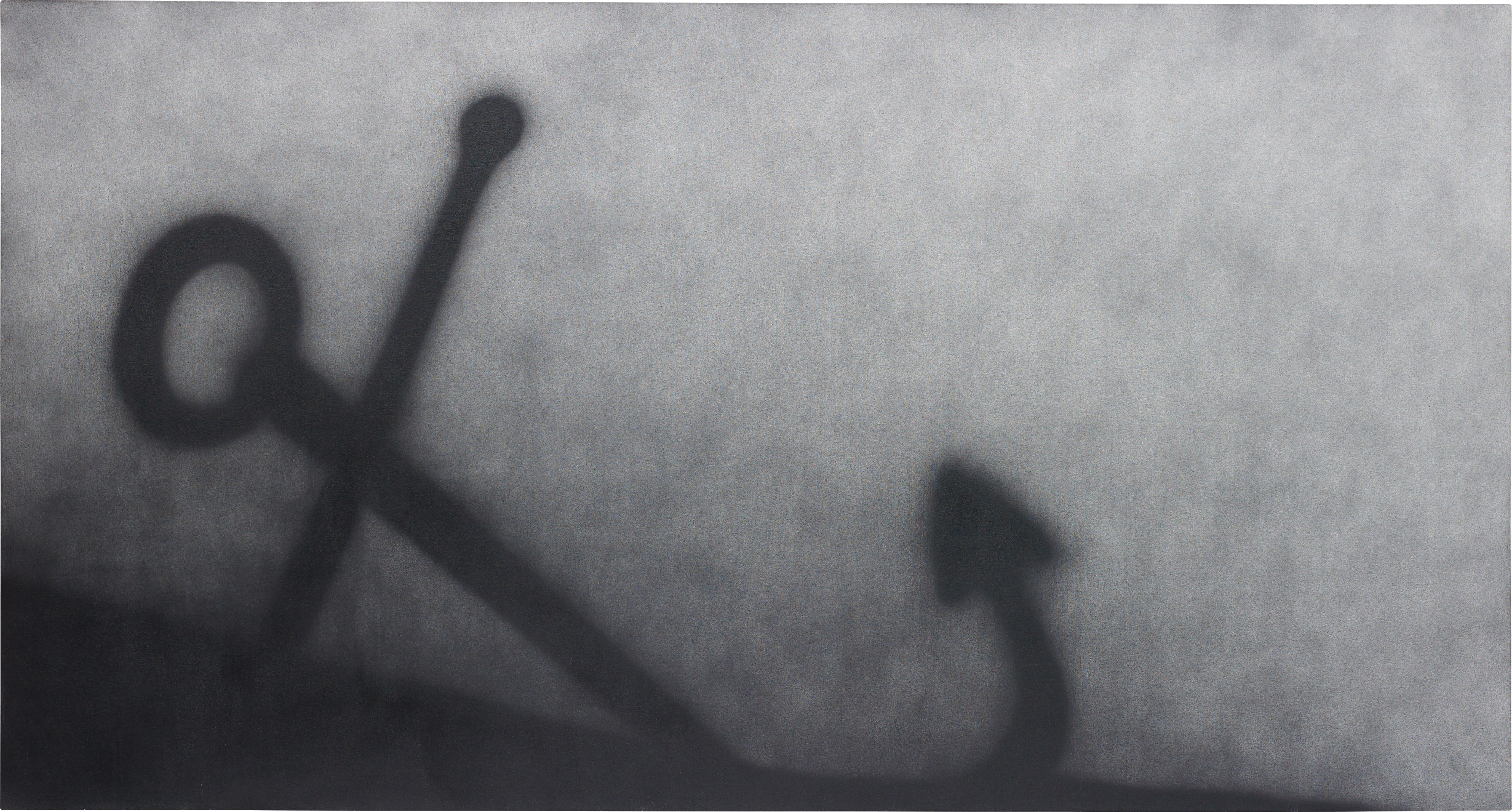

36Ο◆
Ed Ruscha
Anchor Stuck in Sand
Full-Cataloguing
In these paintings, as elsewhere, Ruscha revealed his enduring interest in text and typography. From the very early stages of his career, words and their dual potential for both signification and materiality have been a central preoccupation of the Omaha-born artist. Many of his paintings find a single word or phrase recontextualised in suggestive interplay with typeface and background. The effect is often at once disorientating and strangely elucidating.
The present lot belongs to a distinctive period in Ruscha’s career during which textuality played a less overt role. In the late 1980s and early 1990s, he made a series of silhouette paintings, interweaving light and shadow. Formerly his work had embraced the midday heat, now he turned his attention to the cold and shade. Name, Address, Phone from 1986, for instance, bodies forth a nocturnal black-and-white landscape. Against the pale glow of the sky, a cluster of trees and buildings assert their isolation. Three empty strips interrupt the canvas acting as ‘blanks in which to insert the three words of the title.’ (Richard D. Marshall, Ed Ruscha, London: Phaidon, 2005, p.210)
Anchor Stuck in Sand shares this atmosphere of portent and secrecy, depicting in granular detail the darkened silhouette of a submerged anchor. It is a highly arresting image, and one which evidently made an impression on Ruscha himself; it would return in Invisiglass, a painting of three years later, buried under a skewed clock face and the titular portmanteau. The absence of textuality from Anchor Stuck in Sand is central to its intrigue. There are neither words nor empty strips signifying their absence. Facing the unspeaking image, the viewer glimpses some vast and unfathomable mystery.
Discussing the inception of the silhouette paintings, Ruscha remarked ‘I think they mostly come from photography, although they are not photographically done or anything.’ (Ed Ruscha in conversation with Thomas Beller, Alexandra Schwartz (ed.), Leave Any Information at The Signal, Cambridge, MA: The MIT Press, 2004, p.284) Using an airbrush, the artist was able to remove brushstrokes from his work, creating a still and flat surface. Manifest in Anchor Stuck In Sand is this photographic quality: a sense of haunting and depthless calm.
It is not only photography which looms large over the painting. So too does cinematography. Discussing the impact of the latter on his work, Ruscha remarked ‘I began seeing commercial Hollywood films when I was nine or ten years old … Most of the films I saw at that time were black and white. I’ve got a vivid memory of what it looked like on a big screen and the silvery feeling I got from them; I’m sure it had everything to do with my thoughts about painting.’ (Ed Ruscha, ‘Life in Film: Ed Ruscha,' Frieze, Issue 127, November-December 2009).
In the present lot, as in other paintings from the period, Ruscha returns to these early experiences. Working in black and white, he revisits this ‘silvery feeling,’ refashioning the material of mid-twentieth century cinema within a painterly form. He is especially influenced by the film noir tradition, identifying The Savage Eye and Private Property (both 1960) among his favourites. (Ed Ruscha, ‘Life in Film: Ed Ruscha,' Frieze, Issue 127, November-December 2009). With its foreboding silhouette, intimations of concealment and interplay of light and dark, Anchor Stuck In Sand owes a clear debt to this genre.
Seen from this perspective, the present lot speaks to Ruscha’s enduring concerns. As with much of his best work, it draws upon the culture of entertainment and filmmaking, realizing its potential for mystery and ambiguity. In his paintings of burning buildings and snatches of decontextualized speech, the viewer is confronted by a series of questions whose answers are continually shifting. In all its hazy uncertainty, Anchor Stuck In Sand is very much part of this tradition. As Ruscha himself remarked in the late 1980s, ‘whatever my work was made up of in the beginning is exactly what it is like today … I could have seen the silhouette paintings happening twenty years ago.’ (Ed Ruscha in conversation Bonnie Clearwater, Alexandra Schwartz (ed.), Leave Any Information at The Signal, Cambridge, MA: The MIT Press, 2004, p.293).
Ed Ruscha
American | 1937Quintessentially American, Ed Ruscha is an L.A.-based artist whose art, like California itself, is both geographically rooted and a metaphor for an American state of mind. Ruscha is a deft creator of photography, film, painting, drawing, prints and artist books, whose works are simultaneously unexpected and familiar, both ironic and sincere.
His most iconic works are at turns poetic and deadpan, epigrammatic text with nods to advertising copy, juxtaposed with imagery that is either cinematic and sublime or seemingly wry documentary. Whether the subject is his iconic Standard Gas Station or the Hollywood Sign, a parking lot or highway, his works are a distillation of American idealism, echoing the expansive Western landscape and optimism unique to postwar America.